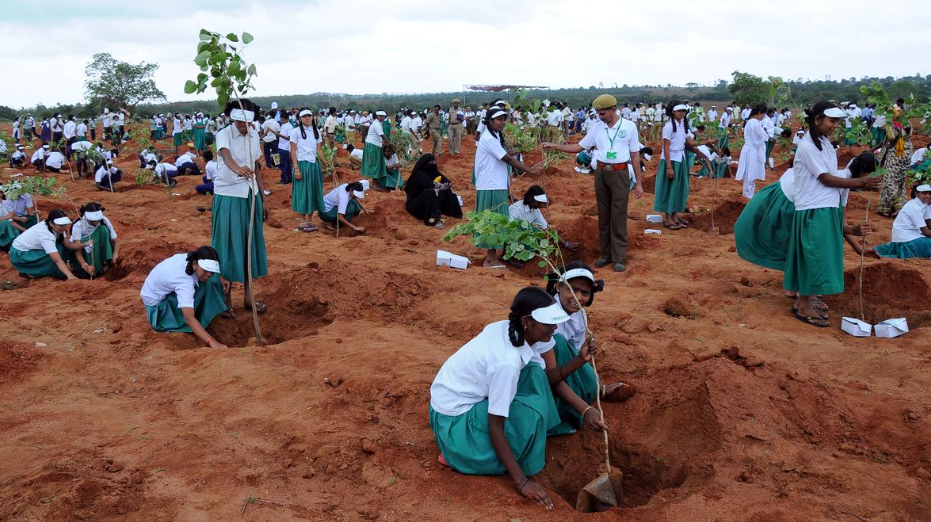The Issue with Tree Planting Schemes (GS Paper 3, Environment)

Context
- The widespread exploitation of forest resources has led to severe degradation of forests globally.
- To address this, the United Nations has declared 2021-2030 as the Decade of Ecosystem Restoration, aiming to restore 350 million hectares of degraded land and bolster global efforts in forest conservation and biodiversity through mass tree planting initiatives.
Introduction
- The degradation of forest landscapes due to unsustainable exploitation of resources has been a pressing issue.
- According to the World Bank, the world has lost approximately 10 million square kilometers of forests since the start of the 20th century.
- In response to this, the United Nations has designated 2021-2030 as the Decade of Ecosystem Restoration, targeting the restoration of 350 million hectares of degraded land.
- This initiative aims to generate $9 trillion in ecosystem services and sequester between 13 to 26 gigatons of greenhouse gases from the atmosphere.
Importance of Tree Planting
- Tree planting is a recognized method to support biodiversity and address climate-related challenges.
- It plays a crucial role in biological carbon sequestration, which helps in removing carbon dioxide from the atmosphere.
- Mass-scale tree planting is seen as a global solution to combat climate change, supported by various governmental and non-governmental organizations.
- In India, the Van Mahotsava ('festival of trees') program, initiated in July 1950, has promoted tree planting and improved forest areas through annual celebrations during the first week of July.
Recent Tree Planting Initiatives
- Recent years have witnessed an increase in tree planting drives led by various agencies, including governments.
- These drives often feature catchy slogans and attract media attention, involving numerous individuals and organizations.
- Notable global initiatives include the "One Trillion Project" by the World Economic Forum, the "Great Green Wall of China," Pakistan's "10 Billion Tree Tsunami," and the "Bonn Challenge," which aims to restore 350 million hectares of degraded land by 2030.
Criticisms of Mass Tree Planting Drives
- Despite their good intentions, mass tree planting drives have faced criticism.
- Issues include limited community participation, inadequate post-planting measures, and the promotion of monocultures, which reduce the effectiveness of carbon sequestration and biodiversity enhancement.
- Environmentalists and scientists have expressed concerns about the lack of ecological and local relevance of these programs and the insufficient involvement of people.
- Studies have shown that planting trees in certain areas, such as grasslands, can harm local ecosystems, destroy habitats, increase wildfire risks, and exacerbate global warming.
Post-Planting Measures and Alternative Approaches
- Planting saplings alone is not sufficient; effective post-planting measures and monitoring are crucial for success.
- Many tree-planting drives, particularly those not supported by governments, lack these provisions.
- Contrary to popular belief, tree planting is not always the most cost-effective climate solution compared to other methods like ecosystem restoration and creating tree islands, which involve planting in smaller, strategically chosen patches.
India’s Challenges
- India faces significant challenges in its tree planting and forest restoration efforts.
- Approximately 10 million hectares of Indian forests are under encroachment, and about 27.5 crore people rely on forests for their livelihoods.
- Since Independence, India has lost nearly 5.7 million hectares of forest land for non-forestry purposes.
- These challenges complicate India's goal to restore 26 million hectares of degraded forests by 2030 and improve forest cover through tree planting.
Policy Changes and Future Strategies
- India has implemented notable policy changes to tackle forestry challenges and enhance restoration efforts.
- However, persistent problems continue to affect these initiatives.
- Mass planting drives need reevaluation to prioritize adequate funding, active community participation, and technical considerations.
- Reoriented strategies, along with public awareness campaigns, social media engagement, and incentivized community participation, can help bring about positive changes in forest ecosystems.
- These efforts can create resilient forests with diverse capacities and capabilities, contributing to ecological balance and environmental sustainability.
Conclusion
- While tree planting is a vital strategy for restoring degraded landscapes and mitigating climate change, it requires proper planning, community involvement, and post-planting care to be effective.
- Addressing the criticisms and improving strategies can enhance the effectiveness of these initiatives.
- Ensuring sustainable practices and prioritizing ecological balance will help achieve long-term environmental goals, ultimately benefiting both the planet and its inhabitants.


